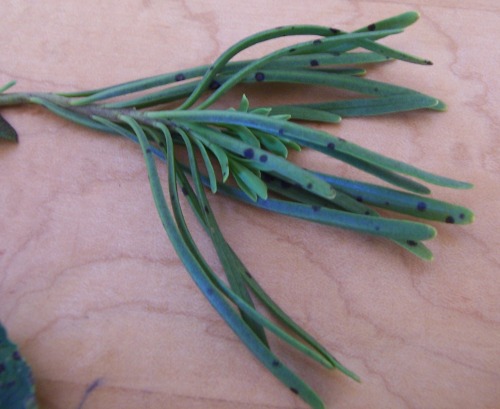I can’t help singing this while I’m picking off diseased leaves from plants in my garden…
Septoria leaf spot, Septoria lycopersici, on a roma tomato leaf from my garden.
Iris leaf spot caused by the fungus Mycosphaerella macrospora.
(I found this drawing of the iris leaf spot on an on-line fact sheet put out by one of our research universities. I get a good laugh out of it every time I look at it. Just thought I would share it with you. I hope you enjoy it as much as I do.)
Anthracnose, Colletotrichum spp., on a hollyhock leaf.
Powdery mildew (there are many genus species of powdery mildew) on a helianthus leaf.
This one puzzles me – I haven’t been able to find anything about it. I found it one morning spread all over the candy tuft. Do you recognize it?
OK, now back to the clean up, clean up, everybody, everywhere, clean up, clean up, everybody do your share; now sing it over and over again until it drives you crazy…
CLEAN UP PRACTICES to help REDUCE the need to sing that song every time you go out into your garden…
- When CHOOSING plants, see if you can find plants that have certain fungus, bacteria, or virus RESISTANCE. You may have to do some research ahead of time. Always LOOK FOR PLANTS THAT ARE STRONG, FULL, HEALTHY LOOKING WITH GOOD COLOR. If there are brown or spotted leaves, don’t buy them. If you get home and find there are some diseased looking leaves that were hiding under the healthy, remove them before planting.
- Use plenty of MULCH around your plants. Fungus and bacteria can overwinter in soil. To prevent it from splashing up onto your plant when watering or when raining, put a nice thick layer of organic matter such as leaves, straw, compost, etc.. around your plants, at least an inch if possible. You can also used something like black plastic.
- WATER AT THE BASE OF THE PLANT. If overhead watering, do it in the morning so plants have a chance to dry off before the cooler and more humid evening temperatures.
- DON’T CROWD the plants. There needs to be plenty of air circulation between plants. Use a good, well balanced fertilizer, such as a 10-10-10. Don’t go heavy on the nitrogen, as it will promote vegetative growth, which will decrease air circulation.
- Probably the best thing is to GET RID OF INFECTED PLANT MATERIAL. I pull off or cut off infected leaves and stems throughout the season and get rid of them. Be careful not to touch uninfected parts of plants with your hands or cutters that are now probably carrying some of those putrid little fungal spores or bacterium. You can dip your cutters into a 10% bleach/water solution between cuts. DON’T PUT INFECTED PLANT MATERIAL IN THE COMPOST PILE!!! THE FUNGUS AND BACTERIA COULD POSSIBLY THRIVE IN THAT SETTING, OVERWINTER, AND BE SPREAD ONTO YOUR GARDEN NEXT YEAR!!! INSTEAD, GET RID OF THEM SO YOU DON’T EVER SEE THEM AGAIN. The same in the fall, clean up all infected plant material and get rid of it!
- If you are working with infected annuals, don’t plant that type of annual in the same spot next year, ROTATE where you place the plants. If you are dealing with perennials, which you don’t want to move around every year, just BE FAITHFUL TO PRACTICE THE ABOVE LISTED PLANT HYGIENE.
No garden is perfect – remember that. Next year is another year – remember that. You garden because you love it – remember that….Try not to sing the clean up song again – remember that…






